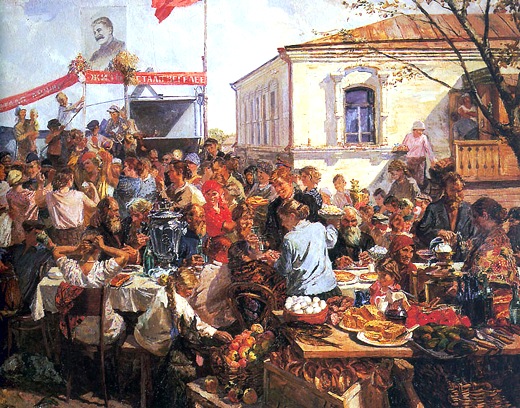 Image above: Painting titled "Feast on a Collective Farm", 1937. From (http://soviethistory.org/index.php?page=subject&show=images&SubjectID=1954thaw&Year=1954&navi=byYear).
By Gwynne Dyer on 6 August 2010 in Straight.com
(http://www.straight.com/article-337565/vancouver/gwynne-dyer-russian-response-wildfires-gives-early-glimpse-climate-change-impact)
Image above: Painting titled "Feast on a Collective Farm", 1937. From (http://soviethistory.org/index.php?page=subject&show=images&SubjectID=1954thaw&Year=1954&navi=byYear).
By Gwynne Dyer on 6 August 2010 in Straight.com
(http://www.straight.com/article-337565/vancouver/gwynne-dyer-russian-response-wildfires-gives-early-glimpse-climate-change-impact)
It cannot be proved that the wildfires now devastating western Russia are evidence of global warming. Once-in-a-century extreme weather events happen, on average, once a century. But the Russian response is precisely what you would expect when global warming really starts to bite: Moscow has just banned all grain exports for the rest of this year.
At least 20 percent of Russia’s wheat crop has already been destroyed by the drought, the extreme heat—circa 40ºC (104ºF) for several weeks now—and the wildfires. The export ban is needed, explained Prime Minister Vladimir Putin, because “we shouldn’t allow domestic prices in Russia to rise, we need to preserve our cattle and build up supplies for next year”. If anybody starves, it won’t be Russians.
That’s a reasonable position for a Russian leader to take, but it does mean that some people will starve elsewhere. Russia is the world’s fourth-largest grain exporter, and anticipated shortages in the international grain market had already driven the price of wheat up by more than 80 percent since early June. When Putin announced the export ban, it immediately jumped by another eight percent.
This means that food prices will also rise, but that is a minor nuisance for most consumers in the developed countries, since they spend only about 10 percent of their income on food. In poor countries, where people spend up to half their income on food, the higher prices will mean that the poorest of the poor cannot afford to feed their children properly.
As a result, some will die—probably a hundred or a thousand times as many as the 30-odd Russians who have been killed by the flames and the smoke. But they will die quietly, one by one, in under-reported parts of the world, so nobody will notice. Not this time. But when food exports are severely reduced or banned by several major producers at once and the international grain market freezes up, everybody will notice.
Two problems are going to converge and merge in the next 10 or 15 years, with dramatic results. One is the fact that global grain production, which kept up with population growth from the 1950s to the 1990s, is no longer doing so. It may even have flatlined in the past decade, although large annual variations make that uncertain. Whereas the world’s population is still growing.
The world grain reserve, which was 150 days of eating for everybody on the planet 10 years ago, has fallen to little more than a third of that. (The “world grain reserve” is not a mountain of grain somewhere, but the sum of all the grain from previous harvests that is still stored in various places just before the next big Northern Hemisphere harvest comes in.)
We now have a smaller grain reserve globally than a prudent civilization in Mesopotamia or Egypt would have aimed for 3,000 years ago. Demand is growing not just because there are more people, but because there are more people rich enough to put more meat into their diet. So things are very tight even before climate change hits hard.
The second problem is, of course, global warming. The rule of thumb is that with every one-degree C rise in average global temperature, we lose 10 percent of global food production. In some places, the crops will be damaged by drought; in others by much hotter temperatures. Or, as in Russia’s case today, by both.
So food production will be heading down as demand continues to increase, and something has to give. What will probably happen is that the amount of internationally traded grain will dwindle as countries ban exports and keep their supplies for themselves. That will mean that a country can no longer buy its way out of trouble when it has a local crop failure: there will not be enough exported grain for sale.
This is the vision of the future that has the soldiers and security experts worried: a world where access to enough food becomes a big political and strategic issue even for developed countries that do not have big surpluses at home. It would be a very ugly world indeed, teeming with climate refugees and failed states and interstate conflicts over water (which is just food at one remove).
What is happening in Russia now, and its impacts elsewhere, give us an early glimpse of what that world will be like. And although nobody can say for certain that the current disaster there is due to climate change, it certainly could be.
Late last year, Britain’s Hadley Centre for Climate Change produced a world map showing how different countries will be affected by the rise in average global temperature over the next 50 years. The European countries that the Hadley map predicts will be among the hardest hit—Greece, Spain, and Russia—are precisely the ones have suffered most from extreme heat, runaway forest fires, and wildfires in the past few years.
The main impact of global warming on human beings will be on the food supply, and eating is a non-negotiable activity. Today Russia, tomorrow the world.
• The second edition of Gwynne Dyer’s latest book, Climate Wars, has just been published in Canada by Random House.
See also: Ea O Ka Aina: Russian Global Warming Crisis 8/5/10
.
No comments :
Post a Comment